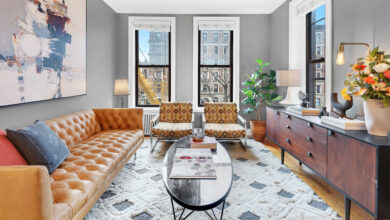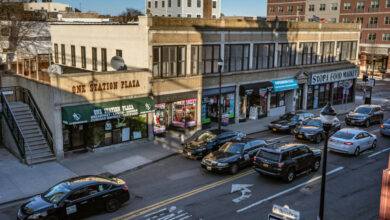An Independent Life of Flowers and Bible Verses in the Bronx

[ad_1]
Molly Mungroo is not a homebody.
“I’m not going to stay in this house and watch these four walls,” she said. “I’m not going to say, ‘I’m old, I don’t go anywhere.’ I don’t do that. I’m independent.”
Between volunteering at a food pantry, going to church and regular walks in her neighborhood, Ms. Mungroo, 71, loves to go out and stay active.
But when she’s in, her apartment — located in the Bronx neighborhood of Mount Hope — is her sanctuary.
“Everything is big. I love it. It’s beautiful,” she said. “I set it up, I cleaned it up nice.”
Ms. Mungroo pays $179 a month for a one-bedroom apartment subsidized by the U.S. Department of Housing and Urban Development, through a program designed to provide affordable apartments with social services for senior residents with low incomes. Residents pay 30 percent of their income for rent, with HUD covering the rest.
To qualify under the program, at least one member of a household must be 62 or older, and the total household income must be under 50 percent of area median income, which in New York City is about $70,000 for a family of three (about $54,000 for one person). Applicants apply to individual buildings and may sit on a wait list, sometimes for years, before securing housing.
About 270 people are on the wait-list for Ms. Mungroo’s building, which houses 136 tenants right now. She said she waited at least three years for a spot after applying to several buildings, and she moved there in 2019.
Her apartment is designed to be wheelchair-accessible, with wide door frames and spacious rooms. Ms. Mungroo likes to keep her surfaces clear and her belongings just so. Her closets contain stacks of neatly folded clothes and linens. She makes sure she always has a vase of flowers on her table.
“This is luxury,” she said. “When my friends come to visit they say, ‘Oh my gosh, Molly, this place is like a hotel.’”
On the walls in each room she’s hung clusters of index cards handwritten with Bible verses. One corner of her living room is what she refers to as her prayer corner, where she reads the Bible — sometimes starting as early as 3 o’clock in the morning, when she wakes up.
“That Bible is my life,” she said. She’s memorized a few Psalms that she’ll recite to herself if she can’t sleep.
$179 | Mount Hope, the Bronx
Molly Mungroo, 71
Occupation: Retired
On sewing: Ms. Mungroo keeps a sewing machine in a corner of her living room and uses it to tailor her own clothes. “Most of my clothes are children’s size,” she said. Because of the wheelchair-accessible design of the apartment, there aren’t cabinets or cupboards below the kitchen counters, so Ms. Mungroo sewed fabric curtains to hide what she stores underneath.
On neighborhood recognition: Ms. Mungroo worked for about two decades at a now-defunct check-cashing store in Hunts Point. First she worked the counter and then became the manager. “I used to run that place,” she said. “Everybody thought I was the owner. I would walk on the street and guys would say, ‘Boss, boss! Hi, boss!’”
The Bronx feels like home for Ms. Mungroo, who moved to the United States from Trinidad in the mid-80s. First she lived in Los Angeles, and then after a divorce, moved to New York City. Her sister and two nieces also live nearby, and she sees them regularly.
Ms. Mungroo’s grown son and three grandchildren are based in Texas, where she also lived for about three years. But she soon grew bored and returned to New York, where she feels much freer.
“I just take the bus when I have nothing to do. I go and walk around. I do a lot of walking,” she said. “You can go anywhere you want, take the bus or the train, but in Texas, if you don’t have a car, you can’t go nowhere.”
She still treks to the Lone Star State for at least a monthlong visit each year. She’s got her own room in her son’s home. But she looks forward to coming back to the rhythms of her life in the city.
Staff in Ms. Mungroo’s building, which is run by the New York Foundation for Senior Citizens, organize activities for the residents, like games of bingo and dominoes, and parties for Christmas, Mother’s Day and Father’s Day. Most of her neighbors speak Spanish, and Ms. Mungroo will greet them using the few words she’s learned.
One person she makes sure to check in on regularly — and sometimes cooks for — is Karina Hernandez, a service coordinator in the building, who assists residents with their benefits, like SNAP and Medicaid. She helped Ms. Mungroo navigate how to secure those benefits when she discovered her identity had been stolen.
“We had to get in contact with the IRS. I had to call Social Security for her, the precinct. We got a lot of people involved,” Ms. Hernandez said.
Ms. Mungroo appreciated the effort.
“She helped me so much. If it wasn’t for her, I don’t know what I would’ve done,” she said.
She gives back, too, spending three days a week at a nearby food pantry, no matter the weather.
“This volunteer work is one of the best things for me,” she said. “The people are so loving and caring. People come to us because we’re really nice to them.”
At the end of the day, Ms. Mungroo might make herself a meal — often salmon and vegetables, curry, stew or noodles — and she likes to unwind by watching a movie from her bed.
“God gave me health and strength, and I’m happy for that,” she said, “and gave me a great place to live.”
[ad_2]
Source link






